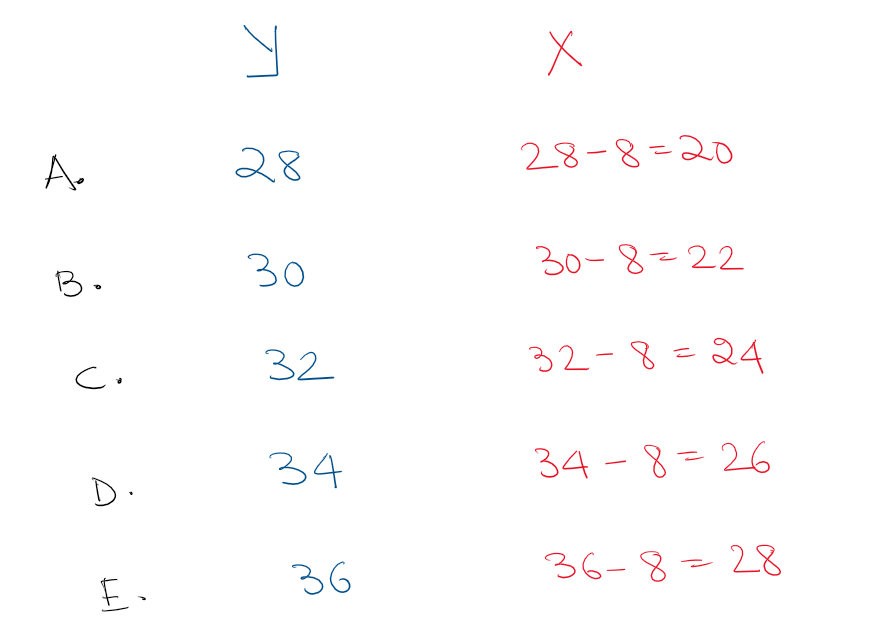nick13 wrote:
Two machines, X and Y, working together at their respective constant rates for 14 hours, and then machine Y, working alone at its constant rate for an additional 4 hours, can produce a total of m items. The time that it takes machine X, working alone at its constant rate, to produce m items is 8 hours less than the time that it takes machine Y, working alone at its constant rate, to produce m items. How many hours does it take machine Y, working alone at its constant rate, to produce m items?
a. 28
b. 30
c. 32
d. 34
e. 36
IMO this a tough one if one tries to solve using an algebraic approach.
- Assume the rate of Machine X = \(x\)
- Assume the rate of Machine Y = \(y\)
Two machines, X and Y, working together at their respective constant rates for 14 hours, and then machine Y, working alone at its constant rate for an additional 4 hours, can produce a total of m items.Inference → To produce m items ⇒ Machine X works for 14 hours, and Machine Y works for 18 hours
14x + 18y = Efforts required to produce m items
The time that it takes machine X, working alone at its constant rate, to produce m items is 8 hours less than the time that it takes machine Y, working alone at its constant rate, to produce m items.Inference → X is faster than Y
Time taken by machine X to produce m items =\( \frac{\text{Efforts required to produce m items} }{\text{Rate of machine X} }\)
Time taken by machine X to produce m items = \(\frac{14x + 18y}{x} = 14 + 18 \frac{y}{x}\)
Time taken by machine Y to produce m items =\( \frac{\text{Efforts required to produce m items} }{\text{Rate of machine Y} }\)
Time taken by machine Y to produce m items = \(\frac{14x + 18y}{y} = 14\frac{x}{y} + 18 \)
Given \((14\frac{x}{y} + 18) - (14 + 18 \frac{y}{x}) = 8\)
\(14\frac{x}{y} + 4 - 18 \frac{y}{x} = 8\)
\(14\frac{x}{y} - 18 \frac{y}{x} = 4\)
Dividing by 2, we get
\(7\frac{x}{y} - 9\frac{y}{x} = 2\)
If, time taken by machine X = \( X \); Rate of machine X ⇒ \(x = \frac{1}{X}\)
If, time taken by machine Y = \( Y \); Rate of machine Y ⇒ \(y = \frac{1}{Y}\)
Transforming our equation in terms of \(X\) and \(Y\)
\(7\frac{\frac{1}{X} }{\frac{1}{Y} } - 9\frac{\frac{1}{Y} }{\frac{1}{X} } = 2\)
\(7\frac{Y}{X} - 9\frac{X}{Y} = 2\)
Now we can use the options to our advantage. The options provide us the value of \(Y\); we can calculate the value of \(X\) as shown below -
Attachment:
 Screenshot 2023-10-23 081303.png [ 43.86 KiB | Viewed 6793 times ]
Screenshot 2023-10-23 081303.png [ 43.86 KiB | Viewed 6793 times ]
My initial hunch is to try Option E first because in that option \(X\) is a multiple of 7, and \(Y\) is a multiple of 9. Hence, the numerator and denominator cancel out when we substitute the values in our equation. No other option provides that advantage (
if I were running on a time crunch, I would choose this as my final answer).
LHS = \(7\frac{36}{28} - 9\frac{28}{36}\)
LHS = \(\frac{36}{4} - \frac{28}{4}\)
LHS = \(9 - 7 = 2\)
RHS = \(2\)
Hence, option E matches.
Option Eavigutman - I would love to see your approach to this question. Can this be solved in a shorter way ?



 95%
(hard)
95%
(hard)
 50%
(03:19)
wrong
50%
(03:19)
wrong  based on 129
sessions
based on 129
sessions

